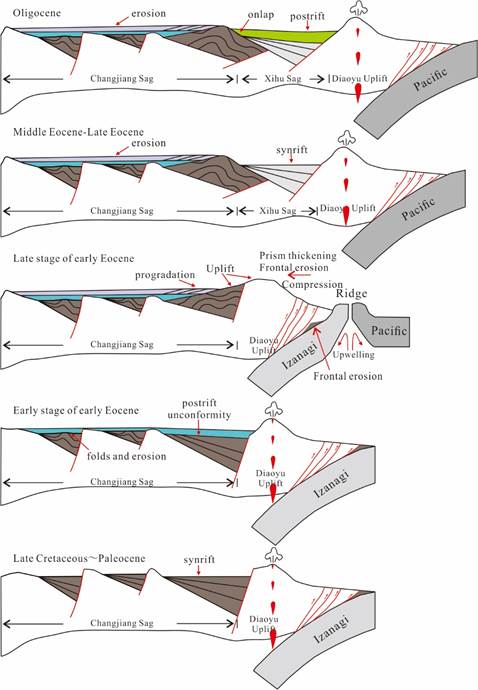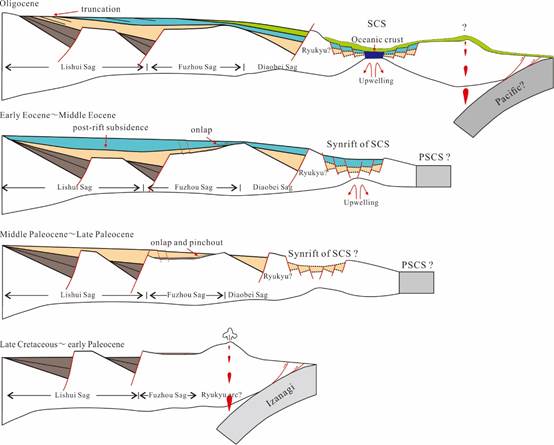Zhu Weilina,c, Zhong Kaia,b, Fu Xiaoweia,b, Chen Chunfengd, Zhang Minqiangd, Gao Shunlid
a Center for Marine Resources, Tongji University, Shanghai, China
b State Key Laboratory of Marine Geology, Tongji University, Shanghai, China
c China National Offshore Oil Corporation (CNOOC), Beijing, China
d China National Offshore Oil Corporation (CNOOC) China Limited (Shanghai), Shanghai, China
Abstract:
Back-arc basins and the related subduction systems have been extensively studied, however back-arc basins exhibiting episodic jumps of extension centers by the subduction of different ocean slabs are poorly known. The East China Sea Shelf Basin (ECSSB) comprises two eastward-younging subparallel depression zones, and its formation and evolution is accompanied by a complicated subduction history and regional tectonic events offer an excellent opportunity to decipher the various geological features of back-arc basins. Here, we review the tectonic and sedimentary features of the subbasins in the ECSSB and its adjacent regions and then reconstruct the evolution of the sedimentary paleogeography. The west depression zone (WDZ) of the ECSSB experienced rifting in the Late Cretaceous during the subduction of the Izanagi Plate at the eastern continental boundary. In the northern WDZ, the Changjiang Depression was mainly dominated by fluvial to lacustrine deposits. This depression experienced strong compression characterized by folds and erosion during the transition from a synrift to postrift setting at the end of the Paleocene. Then another compression event occurred that resulted in extensive folds and uplift accompanied by a large-scale alluvial fan in the eastern Changjiang Depression, coinciding with the subparallel subduction of the Izanagi-Pacific ridge in the early Eocene. However, the Lishui-Jiaojiang Sag characterized by diffuse extension rather than focused rifting in its late rifting period. This sag was mainly covered by paralic to marine deposits and experienced extensive erosion caused by tilted sequences from the late Eocene to Oligocene, which shared the same characteristics as basins around the Taiwan region. It is widely accepted that the formation and evolution of basins around Taiwan were controlled by the evolving of the South China Sea (SCS) and the related regional tectonics. Considering the eastward extent of SCS, it would seem that the southern ECSSB was part of the passive margin of SCS. Accordingly, the southern ECSSB might be significantly influenced by the SCS. The east depression zone (EDZ) commenced rifting in approximately the middle Eocene as inferred from the absence of the compressional event that occurred in the early Eocene and the existence of a thick layer reflection below the Pinghu Fm. (late Eocene) due to the subduction of the Pacific Plate. The depocenters of the ECSSB and the Okinawa Trough jumped eastward successively triggered by the three oceanic slabs of the Izanagi Plate at ~72 Ma, the Pacific Plate at ~50 Ma and the Philippine Sea Plate at ~15 Ma. Thus, a new model for the formation and evolution of the ECSSB is suggested in which a back-arc basin of episodic extension with jumping depocenters in respond to subduction of three oceanic slabs, meanwhile its differences between northern and southern part are caused by the dominant subduction and opening of SCS, respectively. The ECSSB and Okinawa Trough might formed mainly by rollback of the oceanic slab, possibly, due to slab stagnation and toroidal flow related to the subduction, however the effects of large-scale mantle flow cannot be exclusively identified in this research. In addition, further research in this region will give new insights into both the formation and evolution of the SCS and the continental breakup process.

Fig. 1. The formation and evolution model of the northern ECSSB.

Fig. 2. The formation and evolution model of the southern ECSSB.
Full article:https://doi.org/10.1016/j.earscirev.2018.12.009


